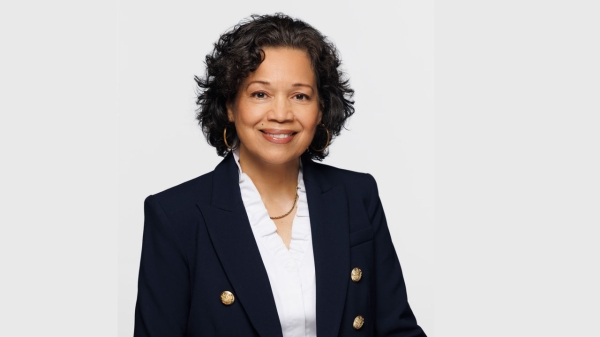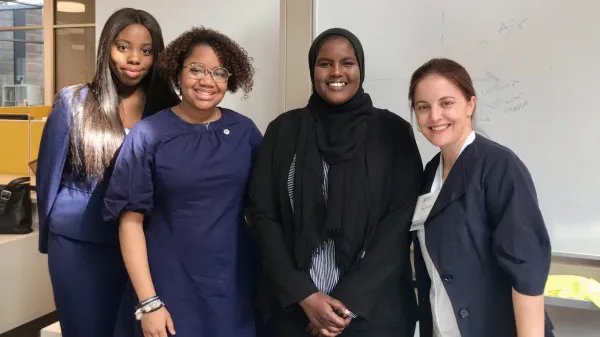ASU researchers partner to help state end violence against Indigenous women, girls

Kate Fox, associate professor in the ASU School of Criminology and Criminal Justice.
After Gov. Doug Ducey signed into law in 2019 a bill creating a study committee to examine ways that Arizona can battle violence against American Indian women and girls, state legislators tapped Associate Professor Kate Fox and a team of Arizona State University researchers to seek the data that could help the state win that fight.
Fox, a professor in the School of Criminology and Criminal Justice, is known for her work collaborating with community partners to improve the safety of Native women. One of the biggest threats to Native women’s safety is a national crisis known by the abbreviation MMIWG, for missing and murdered Indigenous women and girls.
Fox’s reputation attracted the attention of the bill’s author, state Rep. Jennifer Jermaine (White Earth Ojibwe), D-Chandler, and Debbie Nez-Manuel (Navajo Nation), the study committee’s Data Sharing Subcommittee co-chair, who connected her with lawmakers.
Fox, working with her team in the Watts College of Public Service and Community Solutions, now serves as lead researcher and is partnering with committee members to write their final report, due in late 2020. Nez-Manuel has professional experience working with tribal women and urban youth. She also has shared personal realities of missing women.
Fox also collaborates with ASU’s American Indian Policy Institute (Director Traci Morris, Chickasaw Nation of Oklahoma), Office of American Indian Projects (Director Chris Sharp, Colorado River Indian Tribe), American Indian Initiatives (Assistant Vice President Jacob Moore, Tohono O’odham Nation), the Office of Sex Trafficking Intervention Research (Dominique Roe-Sepowitz), as well as LeCroy & Milligan Associates, Inc.
“I feel so honored to be trusted with this work,” Fox said of her partnership with the study committee. Fox is director of the Research on Violent Victimization Lab, also based at Watts College. Her research focuses on crime victimization, particularly against underserved populations, including American Indian women and girls.
Study committee to come up with statewide plan
HB 2570, which passed unanimously in both the state House and Senate, led to the creation of a 23-member study committee composed of legislators, social advocates, law enforcement, and tribal officials, among others. Jermaine — the committee’s chairperson — along with Fox and the rest of the committee are tasked with assessing the scope of the problem, finding out how many women and girls are murdered or missing, and coming up with a statewide plan to reduce the occurrence, Fox said. The plan is expected to include recommendations for state agencies to follow to curb future victimization, she said.
Fox said there’s been an explosion of such legislation in the past year. In May 2019, Arizona was the third state to pass such a law. Since then, a total of 14 states have enacted similar legislation, along with the federal government through a group established by an executive order.
The laws are desperately needed, she said, as violent victimization impacts American Indian women and girls, men and boys, as well as Two Spirit (lesbian, gay, bisexual and transgender) American Indian people.
Fox said a national study found that in some counties, American Indian women were being murdered at a rate 10 times the national average of all murder victims.
“Why are American Indians at such high risk of being murdered or going missing at such high rates?” Fox asked. “Is it connected to human trafficking? Domestic violence? Sexual abuse? We don’t know yet. There’s just not enough good data yet. But we do know that the historical — and current — oppression of American Indian people plays a key role in perpetuating violence against this population.”
Two other studies have shown that American Indian women are more likely to be stalked, sexually assaulted and abused by an intimate partner compared to white, African American and Hispanic women, she said.
READ MORE:
Violence Against American Indian and Alaska Native Women and Men
Prevalence and Characteristics of Sexual Violence, Stalking, and Intimate Partner Violence Victimization
Victims, others are starting to speak
Tradition and culture in many American Indian communities make it taboo to speak someone’s name after they have died, Jermaine said, which sometimes affects whether a missing and/or murdered person situation is reported.
“There are cultural shifts happening along generational lines and communities and individuals are beginning to talk about what happened to them and their loved ones,” Jermaine said. “We have worked with tribal councils to ensure that we are respecting their communities and listening to their members. We also have victim services counselors at every community event to assist families and help connect them with culturally appropriate services.”
Another issue for the committee to consider is how to work with sparse or incorrect victim data.
“Bodies are found and it is sometimes unclear to police whether that person was American Indian,” Fox said. “Officers sometimes put ‘white,’ ‘Hispanic,’ or ‘Asian’ down on their reports. Racial misclassification is still a big problem.”
A report by Canadian authorities about violence against Indigenous women and girls, and the grassroots movement in the U.S., sparked the recent legislation, she said.
“Canada’s report started waking up the U.S. They did a national inquiry — more than 1,000 pages with nearly 100 policy recommendations. They labeled MMIWG as genocide and the U.S. is now finally paying attention,” she said.
In the U.S., the first major report was conducted by the Urban Indian Health Institute, which showed that more MMIWG happens than is known or publicized by the media.
The grassroots movement that had existed in the U.S. for decades, and Canada’s report, ignited into state legislation. Arizona’s version is seen by the American Indian community as one of the better laws and worthy of emulation by others, Fox said.
“All eyes are looking at Arizona,” she said. “We have a robust bill and the goal is for this to have long-term life-saving implications.”
The committee has a big project ahead of it, Fox said, but the crisis it is investigating must be overcome.
“Our goal is to empower communities to be healthier and safer,” she said. “By working to save lives.”
More Law, journalism and politics

CBS News president to give keynote address at Cronkite School’s spring convocation
Ingrid Ciprián-Matthews, president of CBS News, will serve as the keynote speaker at Arizona State University’s Walter Cronkite…

School of Politics and Global Studies director's new book explores mass violence
Why do people commit atrocities and why are certain groups, including religious and ethnic, more vulnerable to large-scale…

ASU faculty contributing to improvement of Wikipedia
Many academics have a love-hate relationship with Wikipedia. While the website has information about almost anything you can…